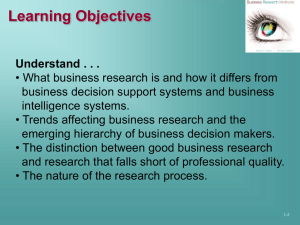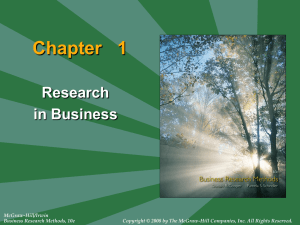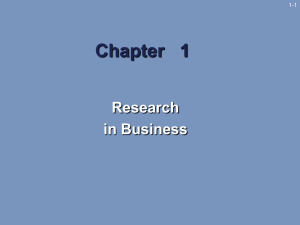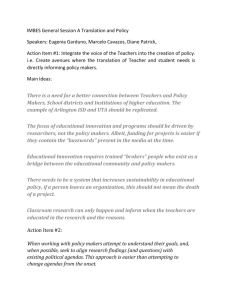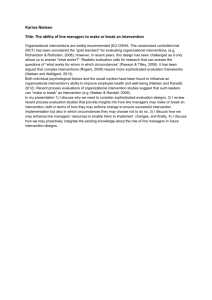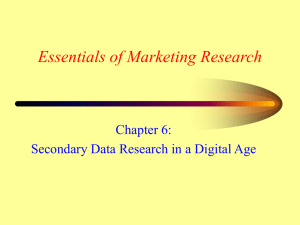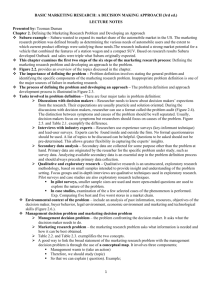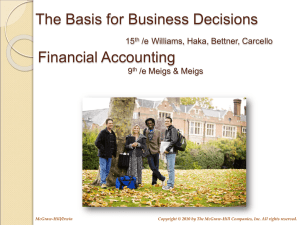Chapter 1 The Role of Research in Marketing
advertisement
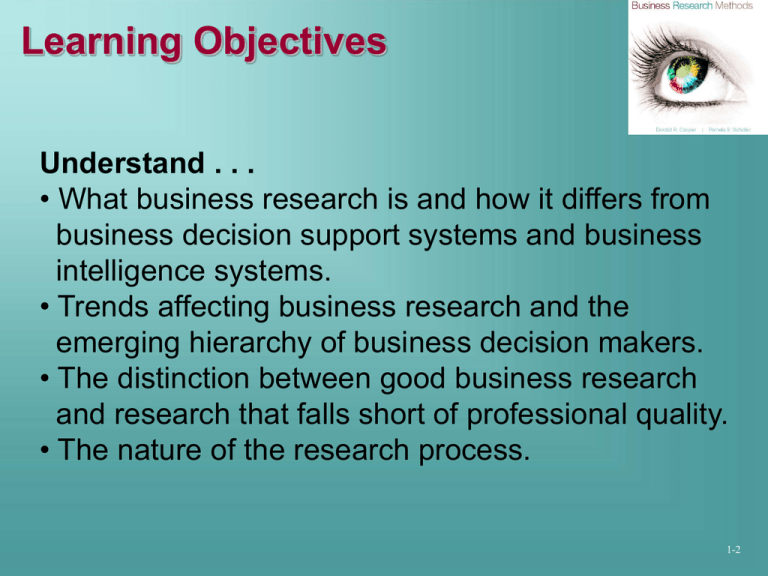
Learning Objectives Understand . . . • What business research is and how it differs from business decision support systems and business intelligence systems. • Trends affecting business research and the emerging hierarchy of business decision makers. • The distinction between good business research and research that falls short of professional quality. • The nature of the research process. 1-2 Data Collectors Face Responsibilities “This is a fantastic time to be entering the business world, because business is going to change more in the next 10 years than it has in the last 50.” Bill Gates, entrepreneur and founder Microsoft 1-3 PulsePoint: Research Revelations 34 The percent of employees who never consider that their bosses, clients, or colleagues think before posting to a blog, discussion forum, or social network. 1-4 Why Study Business Research? Business research provides information to guide business decisions 1-5 Research Should Help Respond to Change “Enterprises have long recognized the need to better sense and respond to business change. What’s different today is that ubiquitous access to information and real-time communications have fostered an ‘always on’ business culture where decision making has become a ‘just-in-time process.’” Business Performance Management Forum 1-6 Business Research •A process of determining, acquiring, analyzing, synthesizing, and disseminating relevant business data, information, and insights to decision makers in ways that mobilize the organization to take appropriate business actions that, in turn, maximize business performance 1-7 Research Should Reduce Risk The primary purpose of research is to reduce the level of risk of a marketing decision 1-8 What’s Changing in Business that Influences Research New Research Perspectives Computing Power & Speed Information Overload Factors Battle for Analytical Talent Technological Connectivity Shifting Global Economics Critical Scrutiny of Business Government Intervention 1-9 Computing Power and Speed Lower-cost Data Collection Integration of Data Better Visualization Tools Factors Real-time Access Powerful Computation 1-10 Business Planning Drives Business Research Organizational Mission Business Goals Business Strategies Business Tactics 1-11 Business Decisions and Research Häagen-Dazs Tactics – Super premium – Dozens of flavors – Small packages – Signature colors on packaging – Available in franchise and grocery stores 1-12 Information Sources Decision Support Systems Numerous elements of data organized for retrieval and use in business decision making Stored and retrieved via – Intranets – Extranets Business Intelligence Systems Ongoing information collection Focused on events, trends in micro and macro-environments 1-13 Sources of Business Intelligence Government/ Regulatory Competitive Economic Demographic Business Intelligence Technological Cultural/ Social 1-14 Hierarchy of Business Decision Makers Visionaries Visionaries Standardized Decision Makers Intuitive Decision Makers 1-15 Minute Main and Business Research 1-16 P&G has a world-class research department 1-17 Research May Not Be Necessary Can It Pass These Tests? • Can information be applied to a critical decision? • Will the information improve managerial decision making? • Are sufficient resources available? 1-18 Information Value Chain Data collection/ transmission Data management Characteristics Decision support systems Data interpretation Models 1-19 The Research Process 1-20 Characteristics of Good Research Clearly defined purpose Detailed research process Thoroughly planned design High ethical standards Limitations addressed Adequate analysis Unambiguous presentation Conclusions justified Credentials 1-21 Categories of Research Applied Basic (Pure) 1-22 Types of Studies Reporting Descriptive Explanatory Predictive 1-23 Key Terms • Applied research • Business intelligence system (BIS) • Business research • Control • Decision support system • Descriptive studies • Explanatory Studies • • • • • Management dilemma Predictive studies Pure research Reporting studies Return on Investment (ROI) • Scientific method • Strategy • Tactics 1-24 Appendix 1a How the Research Industry Works Who Conducts Business Research? 1-26 Some Organizations Use Internal Research Sources 1-27 Some Organizations Use External Research Sources 1-28 Business Research Firms 1-29 Proprietary Research Decision Analyst, Inc. uses Internetbased concept testing called Conceptor to examine new product concepts 1-30 Syndicated Services Nielsen Media Research provides audience data for television programs like Court TV 1-31 Some Syndicated Data Providers AC Nielsen Scarborough Millward Brown Nielsen Media Research Roper ASW CSA TMO Yahoo! ORC International DoubleClick Nielsen/NetRatings Taylor Nelson Sofres Intersearch J.D. Power Associates MediaMark Simmon (SMRB) BRMB Information Resources Inc. 1-32 Specialty Business Research Firms Methodology Process Industry Participant group Geographic Region 1-33 Communication Agencies Sales Promotion Advertising Direct Business Public Relations 1-34 Consultants and Trade Associations 1-35 Trade Associations NHRA CASRO MRA ESOMAR BRA AMA WAOBRP MPA NAB 1-36 Many Firms Conduct Research 1-37 Key Terms •Custom Researcher •Full-service researcher •Specialty researcher •Syndicated data provider •Omnibus researcher •Omnibus study 1-38 Chapter 1 Addendum Research Timeline 1-39 Information Revolution 1971 First CATI survey conducted 1964 OCR shows promise U.S. DOD commissions forerunner of Internet 1968 Word processing first demonstrated 1973 UPC bar-code scanning introduced 1972 Optical laser disk revealed 1975 Microsoft is born 1979 First VisiCalc ships 1960 1980 1964 IBM introduces model 360 1968 SPSS created 1971 Intel introduces first microprocessor 1973 Basic ideas of Internet created 1980 Apple owns 50% of pc market 1976 Apple I released 1-40 Information Revolution 1987 First Internet survey 1981 IBMPC released 1993 WWW experiences 3,400X growth in service traffic 1990s OCR used for data entry 2001 Online survey software widely available 1994 Greenfield Online Introduces online focus group 2003 Wal-Mart commits To use RFID 2002 Web-conferencing Software introduced 2010 1980 1987 IRI conducts first scanner tracking study 1991 WWW developed 1996 Internet World Exposition held 2002 High-speed chip technology for servers 2009 76.3% in US have Internet access 1-41
